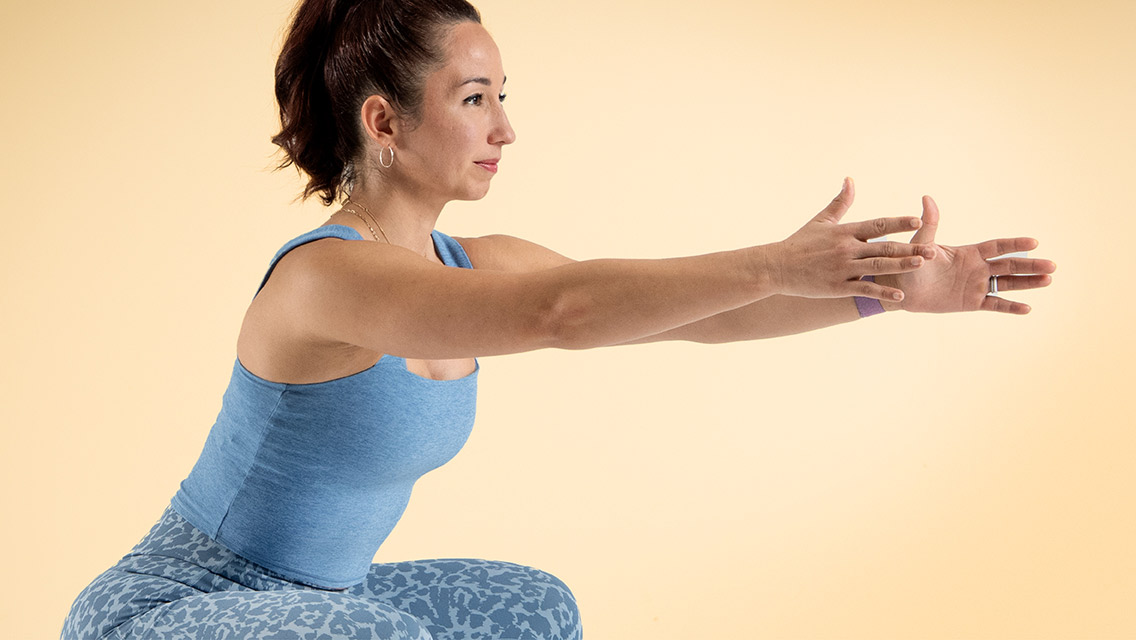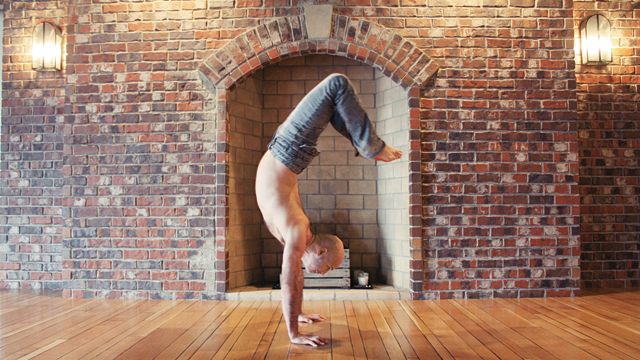Breathing is essential for life — and also for optimal performance. Yet most of us don’t pay attention to how we breathe, and as a result, our breathing pattern isn’t as effective as it could be, especially during exercise.
“Many people generally breathe through their mouth and/or they’re using their neck and shoulder muscles to govern how they breathe,” says fitness coach Harrison Klein, CPT, who trains clients with a breath-first approach at his performance and recovery center, Sauna Strong.
An ideal, functional breath is both nasal and diaphragmatic, says Klein. This means the breath goes in and out through the nose and is powered by the diaphragm, the dome-shaped muscle that sits beneath the lungs. Nasal diaphragmatic breathing optimizes oxygen uptake, which can improve mental clarity and delay muscle fatigue, among other benefits.
“With nasal breathing, we absorb [up to] 20 percent more oxygen than with mouth breathing, which is a profound amount,” he explains. That’s because the air passing through the nasal pathway mixes with nitric oxide, “a vasodilator that opens our blood vessels and increases oxygen circulation throughout the body.”
“With nasal breathing, we absorb [up to] 20 percent more oxygen than with mouth breathing, which is a profound amount.”
Nasal breathing may train the body to tolerate more carbon dioxide, another vasodilator that helps deliver more oxygen to muscles during exercise. Carbon dioxide is also a waste product that’s exhaled once oxygen is exchanged in the lungs. (Fun fact: It’s the buildup of carbon dioxide that creates the urgency to breathe when you hold your breath.)
None of this is to say that breathing through your mouth is necessarily wrong or that all your breathing must be done through your nose. There are myriad breathing techniques — nasal-only breathing, mouth-only breathing, a combination of inhaling through the nose and exhaling through the mouth, exhaling during exertion, holding your breath during exertion, and so on. All manner of breathwork can be used to meet various goals if wielded intentionally and practiced consistently.
For many people, breathing through only the nose during exercise is unfamiliar and uncomfortable — making it a hindrance rather than a help. But nasal diaphragmatic breathing is a skill, and tolerance can be developed. Klein designed this body-weight workout for nasal-breathing newbies to help them begin working with their breath in a different way.
Workout Overview
This nasal-breathing workout follows a circuit format, meaning you’ll perform the exercises one right after the other.
- Do one exercise for 45 seconds, rest for 15 seconds, and move on to the next exercise.
- While you rest between exercises, practice recovery breathing with a double intake: Inhale into your belly through your nose, inhale again into your chest, and then exhale slowly through your mouth. Repeat three times.
- Once you get to the end of the circuit, return to the beginning and repeat until you’ve completed five rounds total.
Don’t worry about racking up tons of repetitions or moving quickly; instead, move with control and let your breaths lead the way. Work at a pace that allows you to sustain nasal breathing. If it gets too hard to breathe steadily in and out through your nose, slow down or pause long enough to regain control. Pair breath to movement, exhaling on the exertion of the movement, and make sure to breathe deep into your belly. Avoid taking shallow, rushed breaths, even as you get tired.
Warm-Up
Energize your nervous system and prepare your breathing muscles with this quick warm-up:
Breathwork
Perform 3 total rounds.
Full Instructions
- In a standing position, inhale and exhale normally through your nose one time.
- After exhaling, plug your nose, hold your breath, and begin walking in place.
- Eventually, perhaps almost immediately, you’ll feel an urgency to breathe. Try to hold your breath a bit longer, working up to holding it for 30 seconds.
- Once you can’t hold your breath any longer, release your nose and inhale in a slow, controlled manner. Exhale quietly and with control, as if there is a feather under your nose that you’re trying not to disturb. Resist the urge to blow out the air forcefully.
- Then take four calm, controlled nasal breaths.
- Finally, inhale through your nose and exhale out your mouth four times.
- That’s one round. Do three rounds total.
The Workout
Body-Weight Squats
Perform for 45 seconds.
Full Instructions
- Stand with feet hip to shoulder width apart, toes pointed forward.
- Inhale through your nose as you squat down, lowering your hips until your thighs are parallel or almost parallel with the floor.
- Exhale through your nose as you press back up to standing.
- Keep your chest up and knees in line with your toes.
Rest for 15 seconds.
Practice recovery breathing with a double intake: Inhale into your belly through your nose, inhale again into your chest, and then exhale slowly through your mouth. Repeat three times.
Pushups
Perform for 45 seconds.
Full Instructions
- Set up in a pushup position: Arms straight, palms in line with your shoulders, feet propped up on your toes about hip width apart.
- Inhale through your nose as you bend at the elbows to lower your chest. Make sure your elbows flare out no more than 45 degrees.
- Exhale through your nose as you push back up.
Do three recovery breaths before moving on to the next exercise.
Rest for 15 seconds while performing recovery breathing.
Bodyweight Reverse Lunges
Perform for 45 seconds.
Full Instructions
- Stand with feet hip width apart.
- Inhale through your nose as you step one foot back, bending both knees to 90 degrees.
- Exhale through your nose as you return to the starting position.
- Alternate legs with each repetition.
Do three recovery breaths before moving on to the next exercise.
Rest for 15 seconds while performing recovery breathing.
Mountain Climbers
Perform for 45 seconds.
Full Instructions
- Set up in a straight-arm plank position: Arms straight, palms in line with your shoulders, feet propped up on your toes about hip width apart.
- Inhale through your nose as you bring one knee toward your chest.
- Exhale through your nose as you return your foot to the floor.
- Alternate legs with each repetition, moving slowly and with control to match the movement to the breath.
Do three recovery breaths before moving on to the next exercise.
Rest for 15 seconds while performing recovery breathing.
Forearm Plank
Perform for 45 seconds.
Full Instructions
- Set up in a forearm plank on the floor with elbows directly under your shoulders, feet propped up on your toes about hip width
- Contract your abdominal muscles to maintain the plank position.
- Inhale and exhale through your nose throughout.
Do three recovery breaths before moving on to the next exercise.
Rest for 15 seconds while performing recovery breathing.
Breath Holds
This may be the most challenging part of the workout because it asks you to slow your breathing at a moment when it’s natural to want to breathe fast. Klein suggests trying to own your breath hold while staying calm through the stress and the desire to breathe fast.
Hold for five seconds before repeating. Perform for 45 seconds.
Full Instructions
- Lie on your stomach and prop your chin up on your forearms.
- Inhale through your nose on a three-count.
- Exhale through your nose on a three-count.
- Hold for five seconds before repeating.
⊗ Perform 5 rounds of the circuit.
⊕ After 5 rounds, perform the coo-down below.
Cool-Down
Box Breathing
Klein suggests practicing a technique known as box breathing to slow your heart rate and help your body transition to recovery mode after your workout. Pick a spot where you can sit or lie down for a few minutes (the floor, a chair, a sauna, etc.) and close your eyes.
Perform 10 rounds.
Full Instructions
- Inhale through your nose on a four-count, filling your belly with air.
- Hold for four seconds.
- Exhale through your mouth on a four-count, pulling your belly toward your spine.
- Hold for four seconds.
Learn More
Master the technique of nasal breathing while you run by using the three expert tips at “Enhance Your Running Performance With Nasal Breathing.”







This Post Has 0 Comments